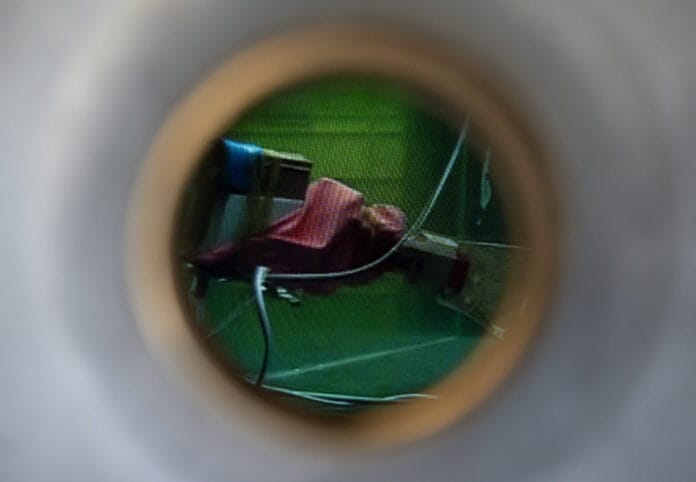Adrianne Wortzel’s CRETACEOUS COLORADO (2007) invites viewers into an alternate timeline, one where evolution took an unexpected turn and the oceans of prehistoric Colorado teemed not with organic creatures, but with robotic life forms. In this speculative universe, technology has not only existed for millennia but has been woven into the very fabric of life itself.
This immersive installation takes the form of a fictional archaeological artifact, suggesting that what we are seeing is a relic from a lost era of engineered biology. At its core, Wortzel’s work brings together paleontology, robotics, and storytelling to form an entirely new genre, one that bridges ancient wonder and futuristic invention.
Inside CRETACEOUS COLORADO
The artwork is presented within a galvanized steel vessel, complete with four screws, a memory card, and a peephole that transforms the act of viewing into a moment of discovery. Peering inside, the viewer encounters a digital tablet playing a video loop: a robotic fish gliding through a reconstructed primordial ocean. This mechanical sea creature, with its lifelike yet artificial motion, feels both familiar and alien, a paradox that lies at the heart of Wortzel’s artistic vision.
The concept originated during Wortzel’s time at Anderson Ranch, Snowmass, Colorado, in 2007, and incorporates a video component created in collaboration with Daniel Bisig. The footage comes from archipelago.ch, a larger project produced during Wortzel’s residency at the Artificial Intelligence Lab, Department of Informatics, University of Zurich in 2004.
By embedding a digital moving image inside a vessel reminiscent of industrial storage or scientific containment, CRETACEOUS COLORADO transforms into a hybrid object: part sculpture, part time capsule, part cinematic portal.
Where Science Meets Art
Wortzel’s work has always inhabited the space where art and science converge. CRETACEOUS COLORADO is not merely a display of technological skill or visual storytelling; it’s a fictional artifact that suggests an entire alternate history. The viewer is encouraged to imagine a prehistory in which technology was not a human invention, but a naturally occurring phenomenon.
By framing the robotic fish as a product of “alternate paleontology,” Wortzel challenges assumptions about both evolution and innovation. The piece blurs distinctions between natural history museums and science fiction laboratories, making us question the authenticity and authority of what we think we know about the past.
A Six-Decade Career of Technological Storytelling
Adrianne Wortzel is an American artist based in New York whose career spans more than six decades. Throughout her practice, she has consistently explored the social and psychological impacts of emerging technologies. Whether working in robotics, performance, video, or interactive installations, Wortzel uses technology not merely as a tool, but as a storytelling medium that reshapes human perception.
Her exhibitions have been shown at major venues including the Whitney Museum of American Art, Asheville Art Museum, Ars Electronica, and Creative Time. Wortzel’s creative life has been enriched by numerous prestigious residencies, such as the Dora Maar Foundation/Houston Museum of Fine Arts, Eyebeam Art and Technology Center, and the Swiss Artists-in-Labs Program at the Artificial Intelligence Laboratory in Zurich.
Recognition and Influence
Over the course of her career, Wortzel has received numerous awards and funding recognitions, underscoring both the originality and the research-driven nature of her work. These include grants from the Franklin Furnace Fund for Performance Art, Greenwall Foundation, New York State Council on the Arts, Science and Art Research Collaborations for Los Alamos and Sandia National Laboratories, PSC-CUNY Research Foundation, the Robert Rauschenberg Foundation, and even a National Science Foundation Award for projects combining robotics and theater.
Her works are housed in significant public collections such as the Morgan Library & Museum, Moderna Museet-Stockholm, Tucson Museum of Art, and MIT Distinctive Collections. This institutional recognition not only cements her legacy as an innovator but also places her work within the historical canon of both contemporary art and technology studies.
Education and Academic Contribution
Wortzel earned her B.A. in Fine Arts from Brooklyn College and an MFA in Computer Arts from The School of Visual Arts. Her dual grounding in traditional fine art and cutting-edge digital practice has allowed her to work fluidly across media, from sculpture and painting to advanced robotic installations.
As a Professor Emeritus in the Department of Emerging Media Technologies at the NYC College of Technology, Wortzel has also shaped the next generation of artists and technologists. Her teaching and mentorship reflect the same interdisciplinary approach that defines her art, encouraging students to think critically about the role of technology in culture.
CRETACEOUS COLORADO in the Context of Her Oeuvre
In many ways, CRETACEOUS COLORADO is a microcosm of Wortzel’s entire career. It incorporates narrative invention, technological collaboration, and speculative history. The use of robotics and digital video echoes her earlier projects exploring artificial intelligence and human-machine interaction, while the fictional archaeological framing connects to her ongoing interest in the storytelling power of artifacts.
The work also embodies a tactile sense of discovery. The peephole format forces the viewer into a position of active searching, mirroring the work of scientists, historians, and explorers. This gesture transforms the audience from passive observers into participants in an imaginative excavation.
The Lasting Impact
Adrianne Wortzel’s artistic practice continues to resonate because it operates at the intersections of fact and fiction, science and art, past and future. CRETACEOUS COLORADO is more than an object to be viewed; it’s an invitation to imagine worlds where technology has ancient roots, where history is not fixed but fluid, and where storytelling can reshape our understanding of reality.
In presenting a robotic fish from a prehistoric ocean in Colorado, Wortzel doesn’t just offer a glimpse into an alternate past; she compels us to reconsider our present and the possible futures that lie ahead.


